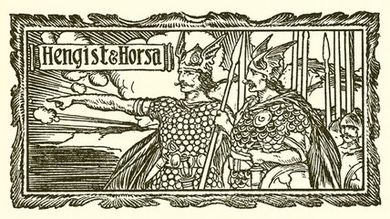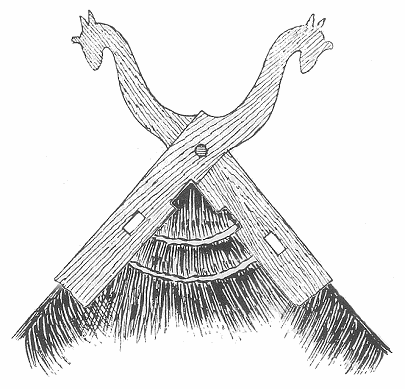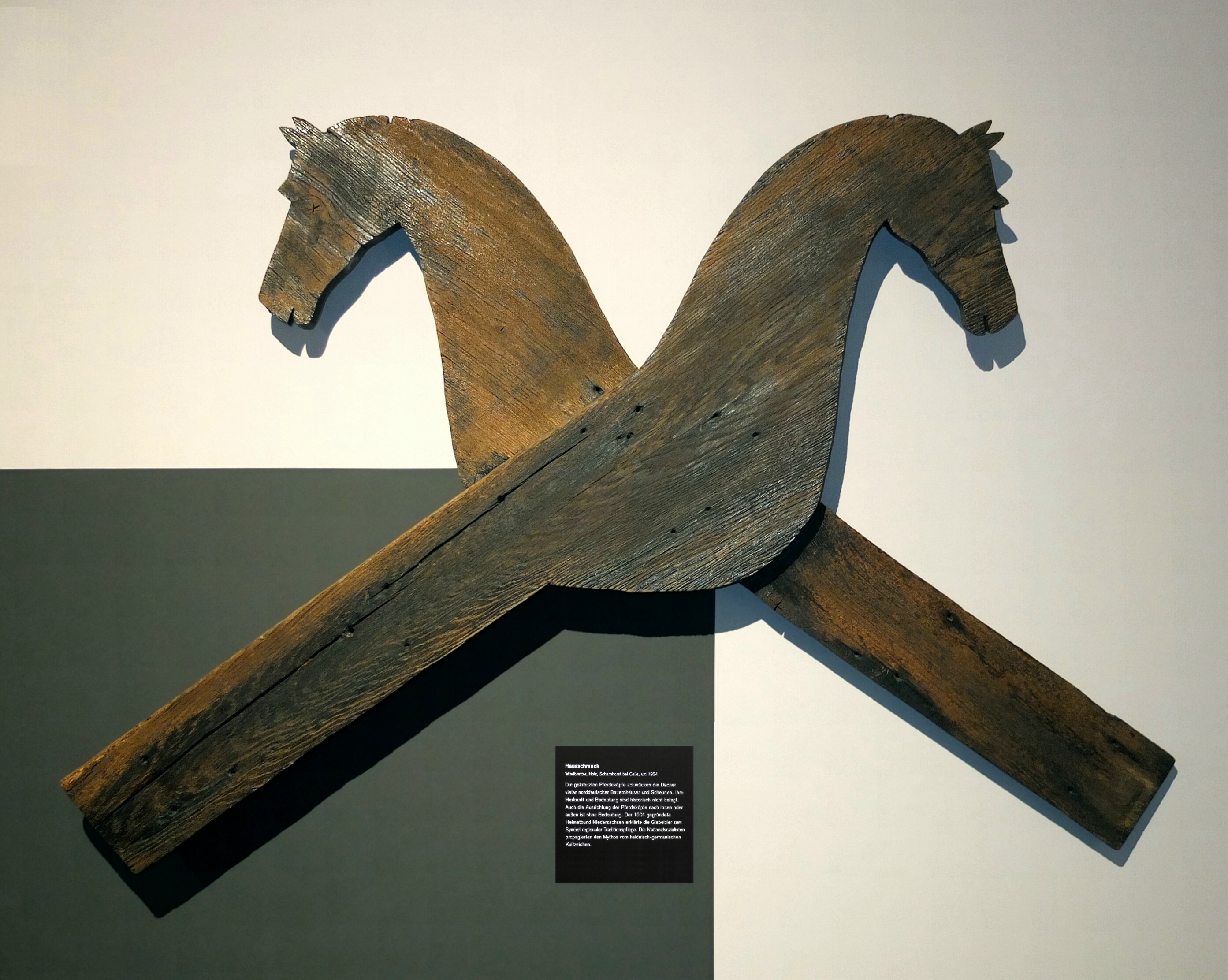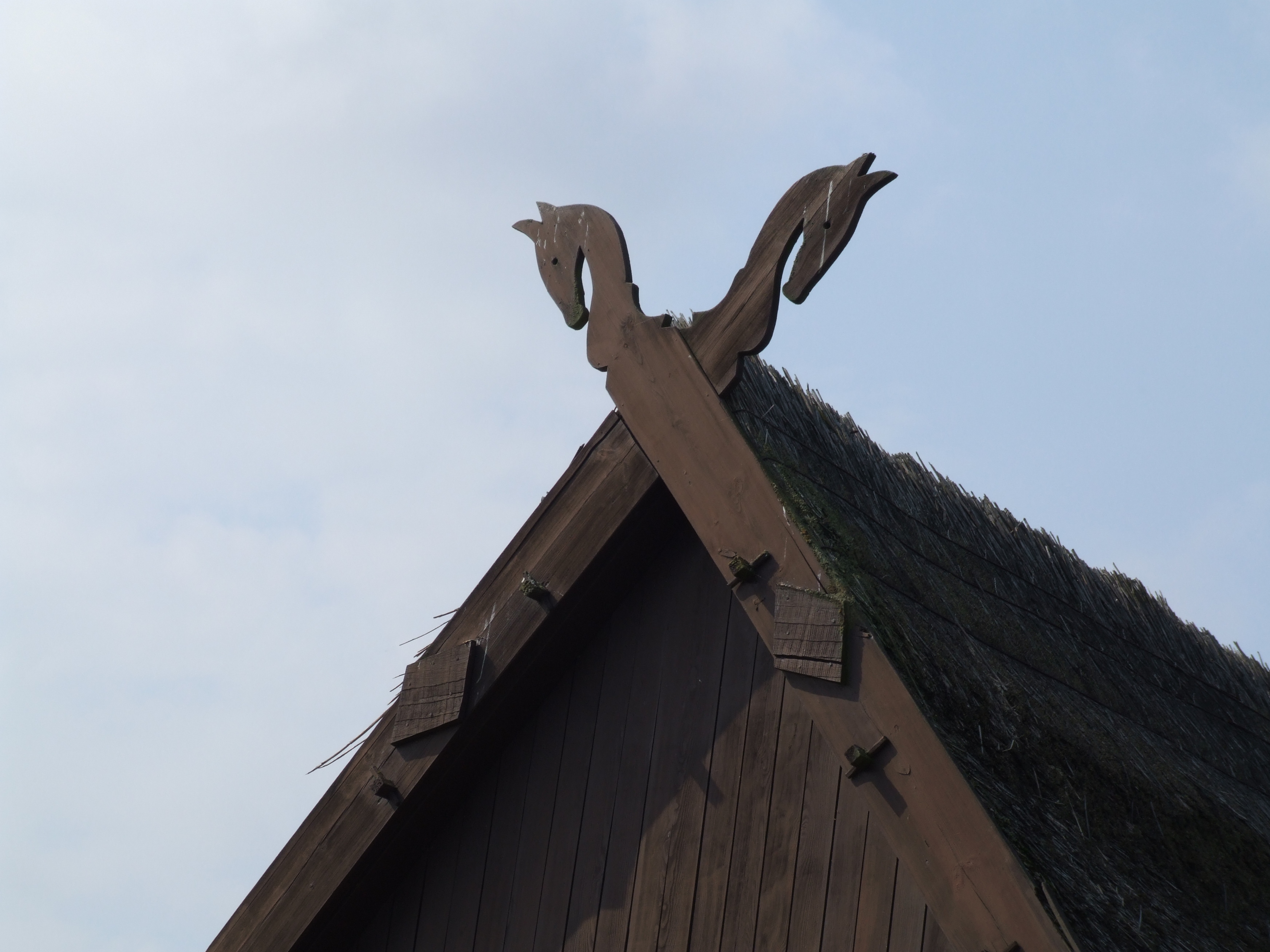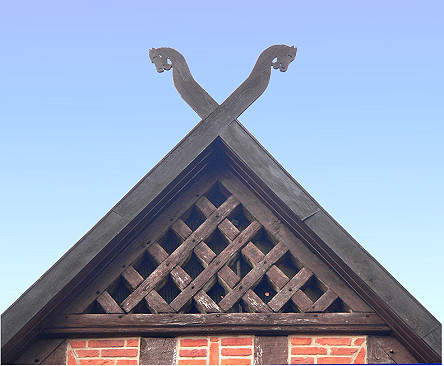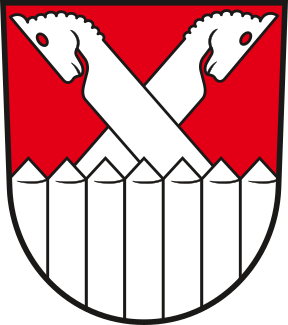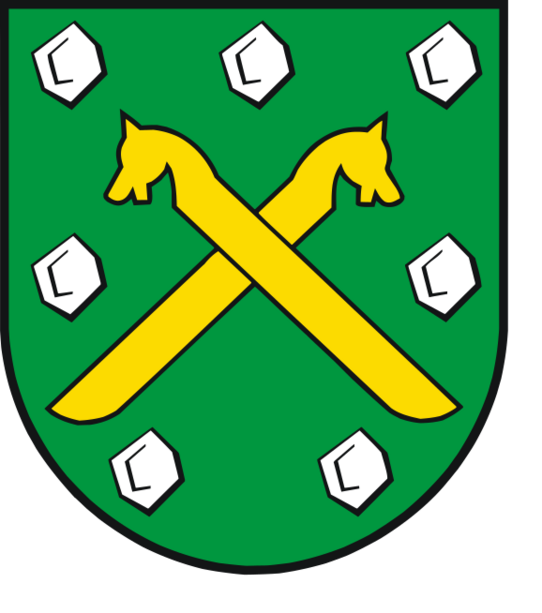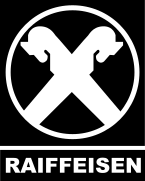Hengist and Horsa facts for kids
Hengist and Horsa were two brothers from Germanic lands. Stories say they led the Angles, Saxons, and Jutes when these groups came to Britain in the 400s AD. Tradition also says Hengist was the very first Jutish king of Kent.
Today, many experts think Hengist and Horsa might be more like legends than real people. Their names sound like animals (horse), and their family trees seem made up. Also, the oldest stories about them, like those by Bede, don't give us many clear facts. Later stories, like the ones in the Anglo-Saxon Chronicle, might tell us more about what people thought in the 800s than what actually happened in the 400s.
Early stories say Hengist and Horsa landed in Britain at Ebbsfleet on the Isle of Thanet. For a while, they worked as soldiers for hire for Vortigern, who was the King of the Britons. But later, they turned against him. British stories say they betrayed him in an event known as the Treachery of the Long Knives. Horsa was killed fighting the Britons. Hengist, however, successfully took over Kent and became the ancestor of its kings.
A character named Hengest, who might be the same person as the legendary leader, appears in old poems like the Finnesburg Fragment and Beowulf. The famous writer J.R.R. Tolkien thought this meant Hengist was a real person.
People used to say that Hengist was buried at Hengistbury Head in Dorset.
Contents
What Their Names Mean
The old English names Hengest and Horsa mean "stallion" and "horse."
The original Old English word for a horse was eoh. The word hors eventually replaced eoh. This is similar to how the word "bear" means 'the brown one'. While some old books call the brother Horsa, others just call him Hors. Some think Horsa might be a shorter, friendly version of a longer name that included "horse."
Old Stories About Them
Bede's History
In the 700s, a writer named Bede wrote his Ecclesiastical History. He wrote that Hengist and Horsa were the first leaders of the Angles, Saxons, and Jutes in England. Bede said Horsa died in a battle against the Britons. He was buried in East Kent, where a monument to him still stood when Bede was writing. According to Bede, Hengist and Horsa were the sons of Wictgils, who was the son of Witta, who was the son of Wecta, who was the son of Woden.
The Anglo-Saxon Chronicle
The Anglo-Saxon Chronicle is a collection of old records written between the 800s and 1100s. It says that in the year 449, King Vortigern invited Hengist and Horsa to Britain. He wanted their help to fight the Picts. The brothers landed at Ebbsfleet and defeated the Picts wherever they fought.
Hengist and Horsa sent messages back home to Germany. They told their people about "the weakness of the Britons, and the richness of the land." They asked for more help, and it was sent. After that, more people came to Britain from "the three powers of Germany": the Old Saxons, the Angles, and the Jutes.
- The Saxons settled in Essex, Sussex, and Wessex.
- The Jutes settled in Kent, the Isle of Wight, and part of Hampshire.
- The Angles settled in East Anglia, Mercia, and Northumbria. This left their original home, Angeln, empty.
Some versions of the Chronicle say that Hengist and Horsa were the sons of Wihtgils, son of Witta, son of Wecta, son of Woden.
In the year 455, the Chronicle says Hengist and Horsa fought against Vortigern at Aylesford. Horsa died there. Hengist then took control of the kingdom with his son Esc. In 457, Hengist and Esc fought the Britons in Crayford and killed many men. The Britons left Kent and ran to London. In 465, Hengest and Esc fought again at the Battle of Wippedesfleot, probably near Ebbsfleet. They killed twelve British leaders. The last mention of Hengist or Horsa in the Chronicle is in 473. It says Hengist and Esc took "immense treasure" and the Britons "fled from the English like fire."
The History of the Britons

The History of the Britons, written in the 800s and thought to be by Nennius, tells a similar story. It says that three ships from Germany, led by Hengist and Horsa, arrived in Britain during King Vortigern's rule. The book gives their family tree, linking them back to a god, but not the Christian God. In 447 AD, Vortigern welcomed Hengist and Horsa and gave them the Isle of Thanet.
After a while, the Saxons grew in number. The Britons could no longer provide for them, so they told them to go home. Vortigern, however, let Hengist send for more of his people to help fight for him. Messengers went to "Scythia" and returned with many warriors and sixteen ships. Hengist's beautiful daughter also came with them.
Hengist held a feast and invited Vortigern. At the feast, Vortigern liked Hengist's daughter very much. He promised Hengist anything he wanted in exchange for her. Hengist asked for Kent. Vortigern agreed, even though he didn't own Kent at the time.
Hengist's daughter was given to Vortigern. Hengist told Vortigern that he would be his adviser and help him win battles. With Vortigern's permission, Hengist sent for his son and brother to fight against the Scots. Ochta and Ebissa arrived with 40 ships. They sailed around the land of the Picts and conquered many areas. Hengist kept sending for more ships, so much so that some islands where his people used to live became empty.
Meanwhile, Vortigern faced problems from a religious leader named Germanus. Vortigern's son, Vortimer, then fought Hengist and Horsa. He pushed them back to Thanet. The war went back and forth, with the Saxons gaining ground and then being pushed back. Vortimer attacked the Saxons four times. In the third battle, at Epsford, both Horsa and Vortigern's son Catigern died. In the last battle, the Saxons were defeated and fled to their ships.
After a short time, Vortimer died. The Saxons then became stronger, helped by other non-Christian groups. Hengist offered peace to Vortigern. Vortigern accepted. Hengist planned a feast to bring British and Saxon leaders together. However, he told his men to hide knives. At a signal, Hengist shouted nima der sexa (get your knives), and his men attacked the Britons. They spared Vortigern, who bought his freedom by giving the Saxons Essex, Sussex, Middlesex, and other lands.
Germanus was then made commander of the British forces. Through prayer, the Britons drove the Saxons to the sea. Germanus prayed for three days, and fire fell from the sky, burning Vortigern's castle with him and others inside. However, the Saxons continued to grow in number. After Hengist died, his son Ochta took over.
History of the Kings of Britain

In the 1100s, Geoffrey of Monmouth wrote The History of the Kings of Britain. This book expanded on the earlier stories.
Arrival in Kent
Geoffrey writes that three ships arrived in Kent, full of armed men led by Hengist and Horsa. King Vortigern was in Canterbury. He ordered that these "tall strangers" be welcomed. Vortigern noticed that the brothers were very noble and graceful. Hengist explained they had left their home in Saxony to offer their services to a prince. This was a Saxon custom when their land became too crowded. Hengist and Horsa were chosen as leaders because of their noble birth.
Vortigern was sad they were not Christians, but happy they had arrived, as he had many enemies. He asked them to help him fight, offering them land and other gifts. They agreed and stayed at his court. Soon after, the Picts attacked. The Saxons fought so bravely that the Picts, who used to win, quickly ran away.
Building a Castle
Vortigern was very grateful and gave the brothers more rewards. Hengist received "large possessions of lands in Lindsey" for his men. Hengist, being clever, told Vortigern that his enemies were everywhere. He also said that Vortigern's own people wanted to replace him with Aurelius Ambrosius. Hengist asked the king to let him send for more soldiers from Saxony. Vortigern agreed, saying Hengist could invite anyone he wanted.
Hengist then asked to build a fortress on a small piece of land. He said it would be small enough to be circled by a single leather thong. Vortigern agreed. Hengist took a bull's hide and cut it into one long thong. He used it to circle a rocky spot, where he built a castle called Thancastre (meaning "thong castle" in Saxon).
Messengers returned from Germany with eighteen ships full of soldiers and Hengist's beautiful daughter, Rowena. Hengist invited Vortigern to see his new castle and the new soldiers. At a feast, Vortigern, who had too much to drink, asked Hengist to let him marry Rowena. Horsa and the men agreed, but only if Vortigern gave Hengist Kent.
Vortigern and Rowena were married. Hengist received Kent. The king was happy with his new wife, but his nobles and three sons hated him for this.
Battles and Betrayal
Vortigern allowed Hengist to invite more Saxons. Octa, Ebissa, and another lord, Cherdich, arrived with 300 ships. Vortigern welcomed them. With their help, Vortigern defeated his enemies. Hengist kept inviting more ships, increasing his numbers daily. The Britons tried to make Vortigern send the Saxons away, but he refused because of his wife. So, his people turned against him and made his son Vortimer king.
The Saxons and Britons, led by Vortimer, fought four battles. In the second battle, Horsa and Vortimer's brother, Catigern, killed each other. By the fourth battle, the Saxons had fled to Thanet. Vortimer surrounded them. The Saxons, unable to fight back, sent Vortigern to ask his son for safe passage back to Germany. While they talked, the Saxons got on their ships and left, leaving their families behind.
Rowena later poisoned Vortimer, and Vortigern became king again. At his wife's request, he invited Hengist back to Britain. Hengist, knowing Vortimer was dead, brought a huge army of 300,000 men. Vortigern planned to fight them. Rowena warned her father. Hengist decided to pretend to make peace.
Hengist's messengers told Vortigern that Hengist had brought many men because he didn't know Vortimer was dead. Now that there was no threat, Vortigern could choose which men to send back to Germany. Vortigern was pleased and arranged to meet Hengist.
Before the meeting, Hengist ordered his soldiers to hide long daggers. At the signal Nemet oure Saxas (get your knives), the Saxons attacked the Britons. They killed 460 British leaders. Hengist held Vortigern captive and threatened to kill him until Vortigern gave him control of Britain's main cities. Once free, Vortigern fled.
Hengist's End
In another part of Britain, a wizard named Merlin told Vortigern that the brothers Aurelius Ambrosius and Uther Pendragon would return to get revenge and defeat the Saxons. They arrived the next day. Aurelius was made king. He marched into the land and burned Vortigern alive in his tower. Then, he went after the Saxons.
Hengist was terrified when he heard about Vortigern's death. He fled with his army. But as Aurelius got closer, Hengist chose his bravest men to defend him. Hengist told them not to be afraid of Aurelius, who had fewer than 10,000 men, while the Saxons had 200,000. Hengist and his men moved to attack Aurelius, but Aurelius was ready for them.
As they marched, Eldol, a British leader, said he really wanted to fight Hengist. Eldol had been at the "Treachery of the Long Knives" but had escaped. Hengist arranged his troops, encouraging them.
The battle began. Both sides lost many men. Eldol tried to find Hengist. The Britons started to win. The Saxons retreated. Aurelius chased them, killing or capturing any Saxon he found. Hengist realized he couldn't hold out. He stopped outside the town and told his men to fight, knowing his safety depended on his sword.
Aurelius reached Hengist, and a fierce fight followed. The Saxons held their ground despite heavy losses. They almost won until more British horsemen arrived. When Gorlois, another British leader, arrived, Eldol knew they had won. He grabbed Hengist's helmet and pulled him into the British lines. The Saxons fled. Hengist's son Octa went to York.
Three days later, Aurelius held a meeting to decide what to do with Hengist. Eldol took Hengist out of the city and killed him. Aurelius, who was fair, arranged for Hengist to be buried. A mound was built over his body, as was the custom for non-Christians. Octa and Eosa surrendered to Aurelius. Aurelius gave them land near Scotland and made a strong agreement with them.
Prose Edda
In the 1200s, an Icelander named Snorri Sturluson briefly mentions Hengist in the Prologue of his Prose Edda. This book gives a story of Germanic history. It says that Woden put three of his sons in charge of Saxony. The ruler of eastern Saxony was Veggdegg, whose son was Vitrgils, the father of Vitta, who was the father of Hengist.
Horse-Head Gables
On old farmhouses in parts of Germany, the decorations on the roof gables (the triangular part of the wall under the roof) were called "Hengst und Hors." This means "stallion and mare" in a local German dialect. These horse-head gables can still be seen today. Some experts believe these show that Hengist and Horsa were originally thought of as mythical, horse-shaped beings. These horse heads might be leftovers from old non-Christian religious practices in the area.
Modern Influence
Hengist and Horsa have appeared in many modern works.
- A play called Hengist, King of Kent (written between 1616 and 1620) features both brothers.
- In 1776, when the Great Seal of the United States was being designed, Thomas Jefferson suggested putting Hengist and Horsa on one side. He saw them as important Saxon leaders from whom Americans claimed to be descended.
- "Hengist and Horsus" are characters in the play Vortigern and Rowena. This play was thought to be a lost work by William Shakespeare in 1796, but it turned out to be a fake.
- The brothers have special plaques in the Walhalla Temple in Germany. This temple honors important figures in German history.
- During World War II, two British military gliders were named after the brothers: the Slingsby Hengist and the Airspeed Horsa.
- The American poet Robinson Jeffers wrote a poem called Ode to Hengist and Horsa.
- In 1949, Prince Georg of Denmark visited Pegwell Bay in Kent. He dedicated a longship called Hugin. This was to remember the landing of Hengest and Horsa at nearby Ebbsfleet 1500 years earlier in 449 AD.
- Even though Hengist and Horsa are not in the old King Arthur stories, some modern Arthurian tales connect them. For example, in Mary Stewart's Merlin Trilogy, Hengist and Horsa are killed by Ambrosius.
- Part of the A299 road on the Isle of Thanet is named Hengist Way.
- Characters named Retinue of Hengist and Band of Horsa appear as mercenaries in the game Crusader Kings III.


